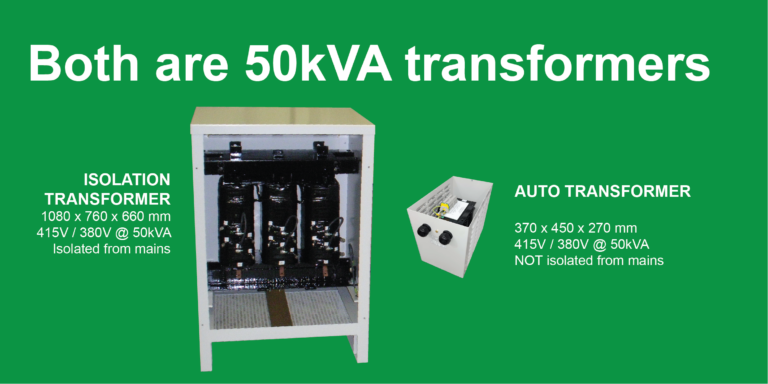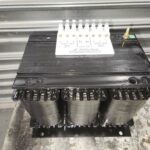The step-down transformer is one of the most commonly used devices for adjusting AC voltage. Not only is this a great tool for safety reasons, but it’s also ideal for reducing energy consumption and lowering monthly utility bills.
Because there are so many options available, choosing the right step-down transformer can be a daunting task. That’s why we’ve provided you with this buying guide on key considerations for selecting the right step-down transformer for you and your energy consumption needs.
Basics of Step-Down Transformers
Before getting into the key buying considerations for selecting an appropriate step-down transformer for your needs, let’s cover the basics of this device.
The step-down transformer is one the most common types of power transformer used in Australia today. As the name suggests, a step-down transformer’s main purpose is to reduce the voltage from a main energy supply, primarily 415V, down to the voltage required for certain equipment, typically designed to run on a different voltage.
3-phase Step Down Transformers
Officially, Australian nominal 3-phase power is 400V (-6% +10%), but it is still much more commonly referred to as 415V (±6%) which was what the voltage used to be before the change in 2000. A lot of electrical equipment brought in from overseas is wired to work on different mains voltages. Europe, China and various other countries are 380V, USA is nominally 208V, Japan is 200V etc.
How It Works
There are two main types of power transformers, either of which can be step-down transformers; isolation transformers and autotransformers.
An isolation transformer is wound with two separate coils, the primary (input) and the secondary (output). Each coil is comprised of a certain number of turns. The primary coil has more turns than the secondary component, allowing the secondary coil to produce a lower voltage than the original source of power.
An auto-transformer is a single winding transformer, providing a smaller & cheaper alternative to a double-wound T/F, useful when isolation from the input mains is not required. Contrary to an isolation transformer, the single coil is wound to the higher (input) voltage, and an output tap is lead out from the turn that corresponds with the required output voltage.
Typically, any equipment brought in from overseas will only require an auto-transformer, as it will be designed to operate within buildings that have isolation. But always check with your installing electrician which is required.
Potential Benefits of Using a Step-Down Transformer
The step-down transformer is a great addition to any home or building that uses low-voltage devices supplied with power from a high-voltage source. Here are a few of the main advantages of buying a step-down transformer:
- Safety: This type of transformer can protect from electrical shock and power surges. This not only protects you but also your electrical devices.
- Energy Efficiency: By lowering voltage, step-down transformers are capable of reducing power consumption, so you can lower your energy bills by using one.
- Ease of Use: Even if you’re not well-versed in technology, anyone can easily install and use a step-down transformer. To power a step-down transformer, just plug it into the wall outlet and then plug your device into the transformer. That’s it!
- Affordability: These days, it’s easy to find an inexpensive transformer that’s safe and effective, making this a great alternative to pricier power supply options.
How to Choose the Right Step-Down Transformer
Pay Close Attention to Power Ratings
When choosing any transformer, the most important consideration is the device’s power rating, including the current and the output voltage. You can find this information labeled on the product in amps, which indicates how much load the transformer can handle without exceeding its limitations.
Consider the Devices You Use Regularly
You should never use a device that utilises more power than the power rating of the transformer. If you do, both the transformer and device could be destroyed, and you could be putting your safety at risk.
Be Mindful of Product Quality
Transformers are built from a series of wires and coils, and the quality of these materials can seriously impact the device’s performance. Depending on design quality, a transformer can last a lifetime, or it can fail within a few years of using it.
That’s why you should always examine the quality of the transformer and its components. It’s also a good idea to read up on reviews and client testimonials regarding the company and its products.
Consider Custom Solutions
If you want a transformer that best suits your needs, consider investing in a custom solution from Southern Electronic Services. We have the tools and knowledge needed to design and build transformers based on your exact specifications.
Get in touch for a free quote on a custom step-down transformer. Just let us know your input/output voltage requirements and your total power needs and we’ll do the rest!
Next Post
Isolation Transformer Basics: A Complete Guide for Beginners
June 27, 2024Other News

Isolation or auto transformer… Which is right for you?
5 Tips to Determine Whether You Need an Isolation Transformer or an Autotransformer Choosing the right transformer for your electrical system is crucial for efficiency, safety, and compliance. Many electricians and engineers often ask: When should I use an isolation transformer, and when is an autotransformer the right choice? To help you make an informed…

Electrical Contractors – Biggest hurdles
The 5 Biggest Challenges Electrical Contractors Face – And How SES Helps Solve Them – How good would it be to complete a job on time, under budget, the security of local support and service, backed by huge warranty periods? You’d be a hero, right? How much money is your company losing by not delivering…
